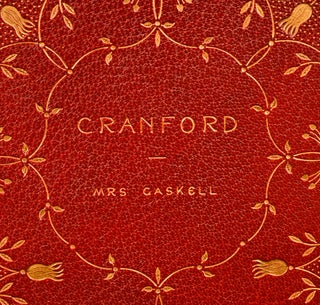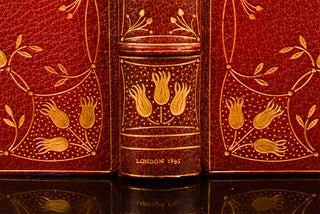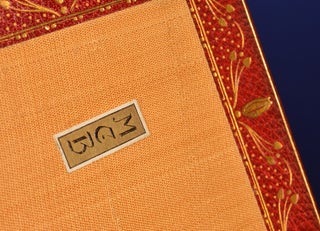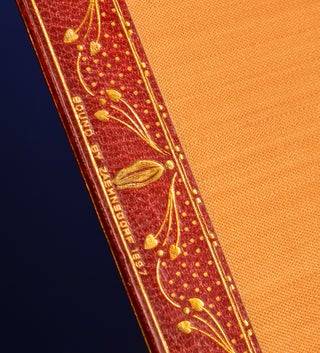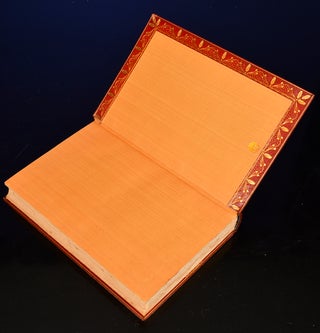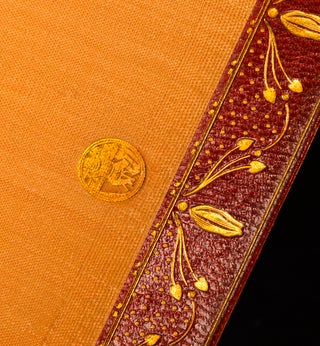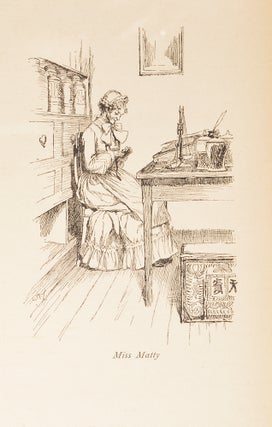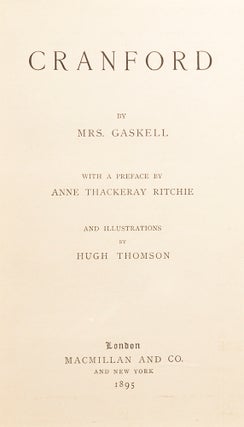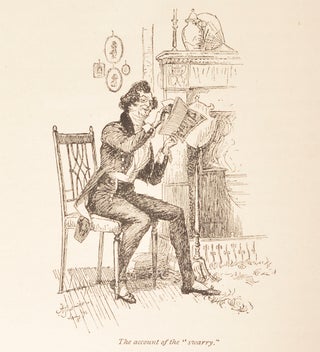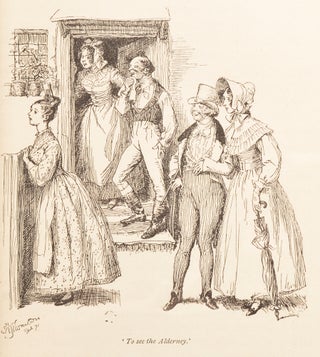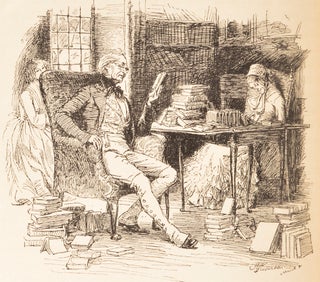Cranford
London: Macmillan and Co., 1895. Item #04214
In a Fine 1897 'Exhibition' Binding by Zaehnsdorf
[ZAEHNSDORF, binders]. THOMSON, Hugh, illustrator. GASKELL, Mrs. [Elizabeth]. Cranford. With a preface by Anne Thackeray Ritchie and illustrations by Hugh Thomson. London: Macmillan and Co., 1895.
Early reprint of the 1891 first Thomson illustrated edition.
Octavo (7 1/2 x 5 inches; 191 x 127 mm.). Frontispiece, xxx, 297, [1] pp. With 110 black and white illustrations in the text. Occasional foxing or staining especially on pp. 16/17; 104/105; 144/145, and 270/271.
A fine 'Exhibition' binding by Zaehnsdorf, executed in 1897 (stamp-signed in gilt on front turn-in). Full crimson crushed levant morocco, covers bordered in gilt and decoratively tooled in gilt and pointille in an elaborate floral design, front cover lettered in gilt. Spine with five raised bands, decoratively tooled and lettered in gilt in compartments, gilt ruled board edges,wide and elaborate gilt decorated turn-ins, ochre silk liners and end-leaves, top edge gilt, others uncut. The rear liner has the Zaehnsdorf 'Exhibition' stamp in gilt. Joints expertly and almost invisibly repaired, one corner a little bumped, still a very early and fine example of a Zaehnsdorf 'Exhibition' binding, housed in a red morocco edged, felt-lined, red cloth slipcase.
Cranford, which originally appeared as a serial in Charles Dickens' magazine, Household Words, 1851-53, and saw its first publication in book form in 1853, is "a series of linked sketches of life among the ladies of a quiet country village in the 1830s...The greatest charm of Cranford, which has kept it unfailingly popular, is its amused but loving portrait of the old-fashioned customs and 'elegant economy' of a delicately observed group of middle-aged figures in a landscape" (Oxford Companion to English Literature).
Mrs. Elizabeth Gaskell (1810-1865), a "strong and independent-minded woman" (The Feminist Companion to Literature), was an important proto-Feminist writer who often tackled unorthodox subjects in her novels. Cranford, for example, concerns a community of spinsters who glory in their freedom from male interference. Mrs. Gaskell was "'the most popular, with small question, the most powerful and finished female novelist of an epoch singularly rich in female novelists'" (Enclyclopedia of British Women Writers, p. 264, citing Mrs. Gaskell's obituary in The Athenaeum).
"Critical awareness of Gaskell as a social historian is now more balanced by awareness of her innovativeness and artistic development as a novelist. While scholars continue to debate the precise nature of her talent, they also reaffirm the singular attractiveness of her best works" (ibid) of which Cranford is one.
Hugh Thomson (1860-1920) was born in Kingsgate Street, Coleraine, Co. Londonderry, the eldest child of John and Catherine Thomson. Thomson was educated in the model school in Coleraine. At age fourteen he started working at the local linen industry but three years later he entered the employment of Marcus Ward & Co., colour printers and publishers in Belfast where his talent for drawing was encouraged by John Vinycomb, head of the art department. He married Jessie Naismith Miller in 1884 and moved to London, where he took up employment with Macmillan & Co. on the English Illustrated Magazine, joining some of the most distinguished writers and illustrators of the day. Thomson provided scenes of Covent Garden and Regency Bath and the illustrations for the Addison and Steele Spectator papers Days with Sir Roger de Coverley (1886-7). Thompson's style reflected the nostalgia of the time, his fine line drawing of rural characters and gentle countrified society appealing to the imagination of the public.
Price: $2,750.00

 I have been in the rare and antiquarian book business for over forty years; my family has been in the rare books business since 1876. Rare books are in my blood.
I have been in the rare and antiquarian book business for over forty years; my family has been in the rare books business since 1876. Rare books are in my blood.



